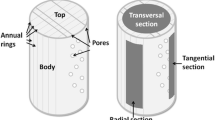Abstract
Fourier transform infrared (FTIR) spectroscopy was applied to determine the type of surface treatment and dose used on cork stoppers and to predict the friction between stopper and bottleneck. Agglomerated cork stoppers were finished with two different doses and using two surface treatments: P (paraffin and silicone), 15 and 25 mg/stopper, and S (only silicone), 10 and 15 mg/stopper. FTIR spectra were recorded at five points for each stopper by attenuated total reflectance (ATR). Absorbances at 1,010, 2,916, and 2,963 cm−1 were obtained in each spectrum. Discriminant analysis techniques allowed the treatment, and dose applied to each stopper to be identified from the absorbance values. 91.2% success rates were obtained from individual values and 96.0% from the mean values of each stopper. Spectrometric data also allowed treatment homogeneity to be determined on the stopper surface, and a multiple regression model was used to predict the friction index (If = Fe/Fc) (R 2 = 0.93).






Similar content being viewed by others
References
Anderson VL, McLean RA (1974) Design of experiments. A realistic approach, Marcel Dekker Inc., New York
Bradley E, Castle L (2003) Investigation of the migration of chemicals from agglomerate, plastic and natural cork stoppers. Report FD 02/27 Food Standards Agency, York, England
Canals T, Riba JR, Cantero R, Cansino J, Domingo D, Iturriaga H (2008) Characterization of paper finishes by use of infrared spectroscopy in combination with canonical variate analysis. Talanta 77(2):751–757
Chatonnet P, Labadie D (2003) Control of the stoppers conformity: objectives and parameters for professionals. Rev Fr d `Oenol 198:20–29
Fortes MA, Rosa ME, Pereira H (2004) Cork. IST Press, Lisboa, Portugal
Giunchi A, Versari A, Parpinello GP, Galassi S (2008) Analysis of mechanical properties of cork stoppers and synthetic closures used for wine bottling. J Food Eng 88(4):576–580
Gonzalez-Adrados JR, Gonzalez-Hernandez F, De Ceca JLG, Caceres-Esteban MJ, Garcia-Vallejo MC (2008) Cork-wine interaction studies: Liquid absorption and non-volatile compound migration. Journal International Des Sciences De La Vigne Et Du Vin 42(3):163–168
Kontoudakis N, Biosca P, Canals R, Fort F, Canals JM, Zamora F (2008) Impact of stopper type on oxygen ingress during wine bottling when using an inert gas cover. Aust J Grape Wine Res 14:116–122
Lopes P, Saucier C, Teissedre PL, Glories Y (2007) Main routes of oxygen ingress through different closures into wine bottles. J Agric Food Chem 55(13):5167–5170
Ortega-Fernandez C, Gonzalez-Adrados JR, Garcia-Vallejo MC, Calvo-Haro R, Caceres-Esteban MJ (2006) Characterization of surface treatments of cork stoppers by FTIR-ATR. J Agric Food Chem 54(14):4932–4936
Pereira H (2007) Cork: Biology. Production and Uses. Elsevier, Oxford, UK
Riboulet JM, Alegoët C (1986) Practical aspects of wine corkage. Bourgogne Publications, Chaintré, France
Six T, Feigenbaum A (2003) Mechanism of migration from agglomerated cork stoppers. Part 2: Safety assessment criteria of agglomerated cork stoppers for champagne wine cork producers, for users and for control laboratories. Food-Additives-and-Contaminants 20(10):960–971
Six T, Feigenbaum A, Riquet A-M (2002) Mechanism of Migration from Agglomerated Cork Stoppers: I. An Electron Spin Resonance Investigation. J Appl Polym Sci 83:2644–2654
Skouroumounis GK, Kwiatkowski MJ, Francis IL, Oakey H, Capone DL, Duncan B et al (2005) The impact of closure type and storage conditions on the composition, colour and flavour properties of a Riesling and a wooded Chardonnay wine during five years’ storage. Aust J Grape Wine Res 11(3):369–384
Yang P, Meng XF, Zhang ZY, Jing BX, Yuan J, Yang WT (2005) Thickness measurement of nanoscale polymer layer on polymer substrates by attenuated total reflection infrared spectroscopy. Anal Chem 77(4):1068–1074
Acknowledgments
Financial support was provided by Project INIAFEDER-RTA06-119-C02-01. The authors are grateful to the Catalonian Cork Institute (ICSuro) for its cooperation and to M. L. Caceres, L. Ortiz, and Dr. R. Juanola for their help.
Author information
Authors and Affiliations
Corresponding author
Rights and permissions
About this article
Cite this article
Gonzalez-Adrados, J.R., Garcia-Vallejo, M.C., Caceres-Esteban, M.J. et al. Control by ATR-FTIR of surface treatment of cork stoppers and its effect on their mechanical performance. Wood Sci Technol 46, 349–360 (2012). https://doi.org/10.1007/s00226-011-0403-5
Received:
Published:
Issue Date:
DOI: https://doi.org/10.1007/s00226-011-0403-5




